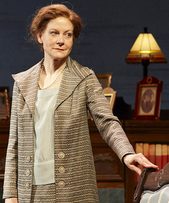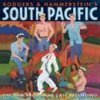SITE GUIDE
SEARCH
REVIEWS
REVIEW ARCHIVES
ADVERTISING AT CURTAINUP
FEATURES
NEWS
Etcetera and
Short Term Listings
LISTINGS
Broadway
Off-Broadway
NYC Restaurants
BOOKS and CDs
OTHER PLACES
Berkshires
London
California
New Jersey
DC
Connecticut
Philadelphia
Elsewhere
QUOTES
TKTS
PLAYWRIGHTS' ALBUMS
LETTERS TO EDITOR
FILM
LINKS
MISCELLANEOUS
Free Updates
Masthead
A CurtainUp Review
The Orphans' Home Cycle: PartThree
|
The Orphans' Home Cycle Part Three at the Signature Theater
By Elyse Sommer
Having watched Horace Robideaux's struggle to find his place in the world and forge new family bonds to erase the pain of those broken when his widowed mother remarried, the audience will root for him to continue to bask in the affection of his new family, the Vaughns. Indeed, despite the senior Vaughns' objections to Horace as a husband for their daughter for most of the Cycle's second part, the birth of his and Elizabeth's baby have not only brought Elizabeth's parents around but has made them respect and love Horace. In fact, they wish Brother, their charming but ne'er do well son were more like him. The marriages of both the Vaughns and Elizabeth and Horace are strong enough to withstand sadness and there's plenty of that: The flu does not spare their family. . . the war ends before Mr. Vaughn's gung-ho patriotism can help to send Horace and Brother in harm's way (Mrs. Vaughn's comment that at least war is one thing they won't ever have to worry about prompted somewhat ironic chuckles from the audience at last Saturday's matinee). . . Horace gets his own store but is buffeted by a bad economy even as some of his Houston kinfolk become rich as a result of investments he rejected as too risky. While Horace's mother is back in the picture, she's never going to be an unconditionally loving presence in his life. And as Brother Vaughn is like the leopard who can't change his spots, so sister Lily Dale remains self-absorbed and spoiled. The darkness that overarches the first act is leavened with much humor in Cousins. Various cousins rattle off kinship connections with often hilariously mind-boggling speed. In typical Southern style, a person's given name is tied to how close the relationship is (first or second cousin, once or twice removed). Some of these amusing exchanges take place in Horace's store between a cousin who's his only employee and another cousin usually too drunk to stay on his feet, let alone keep all the relatives straight. When Horace is called to his desperately ill mother's hospital bedside in Houston, the grimness of the situation is offset by similarly amusing chatter of kissin' cousins. The staging is once again incredibly atmospheric and fluid and the actors better than ever, be it in small or large parts. Horton Foote's daughter Hallie appears most prominently in this final part, mostly as Mrs. Vaughn, but also delightfully funny as one of the newly rich kissin' kin mentioned above. She also gets to wear quite a few of David C. Woolard's smashing costumes. Maggie Lacey is more endearing than ever as the gentle, loving Elizabeth. She breaks your heart when she confides her conflicted feelings about the baby she is about to have and the one she's lost to the only one she can talk to about this — a mute girl she befriended towards the end of the second part. Bill Heck's Horace has matured convincingly into a settled family man, but perhaps my favorite in this whole wonderful cast is Dylan Riley Snyder, this time around as Elizabeth and Horace's son, a nine-year-old bookworm who unsurprisingly is reading Huckleberry Finn, another saga of a rootless boy. One of the more memorable scenes in the last act is an interchange between Horace Jr. and Gertrude (Jasmine Amii Harrison), a young colored girl, after Papa Vaughn's death. Horace Jr. not only confirms Gertrude's comment that his grandfather was a smart man but also lists the achievements of his dad's maternal great-grandfather who was once acting governor of Texas and had two big plantations and one hundred twenty slaves. This doesn't so much impress Gertrude as make her declare herself happy not to have lived at a time when she would have been a slave, thus making Horace suddenly connect his ancestors' slave ownership with Gertrude and her family. It seems too bad to have to leave all these characters we've become so involved with in 1928, with the Great Depression about to erupt and another worldwide conflict on the horizon. Fortunately we do know that young Horace Robideaux will survive to thrive as playwright and national treasure, Horton Foote. While there's talk of bringing this epic saga to Broadway next Fall, the logistics of doing so both in terms of staging and economics are daunting. But as Brother wistfully tells Horace at the end: "Don't be too sure. Don't be too sure about anything in this world." So don't wait. Get your ticket while you can. Part One: The Story of a Childhood: 1902-1910 Part Two: The Story of a Marriage 1912-1917- Horton Foote Backgrounder January 27th Update: The Signature has added 6 weeks to the current schedule so you'll have a chance to see the Cycle through May 5th. They've also added 2 Marathon performances. Production Notes The Orphans' Home Cycle: Part Three: The Story of a Family 1918 . . . Cousins . . . The Death of Papa By Horton Foote Directed by Michael Wilson Cast: Annalee Jeffries (Mrs. Boone, Corella Davenport), Dylan Riley Snyder, (Horace, Jr.), Virginia Kull (Bessie Stillman, Minnie Robedaux Curtis), Emily Robinson (Irma Sue), Maggie Lacey (Elizabeth Vaughn Robedaux), Justin Fuller (Dr. Greene), Jenny Dare Paulin (Lily Dale Kidder), Hallie Foote (Mrs.Vaughn, Lola Reeves), Bill Heck (Horace Robedaux), Devon Abner (Pete Davenport), Bryce Pinkham (Brother Vaughn), James DeMarse (Mr. Vaughn), Pamela Payton-Wright (Inez Thornton Kirby), Stephen Plunkett (Will Kidder), Pat Bowie (Woman in Cemetery, Nurse, Eliza), Gilbert Owuor (Sam Goldman), Henry Hodges (a boy), Justin Fuller (Gordon Kirby), Lucas Caleb Rooney (Lewis Higgins), Leon Addison Brown (Sylvester Malone), Jasmine Amii Harrison (Gertrude), Charles Turner (Walter) Scenic Design: Jeff Cowie and David Barber Projections Design: Jan Hartley Lighting Design: Rui Rita Original Music and Sound Design: John Gromada Costume Design: David C. Woolard Choreographer/Movement Director: Maxwell Williams Wig and Hair Design: Mark Adam Rampmeyer Fight Director: Mark Olsen Running Time: 3 hours, with 2 10-minute intermissions Signature Theatre Company at the Peter Norton Space 555 West 42nd Street opening 1/26/10; closing 3/29/10 For performance calendar, including the 3 all-daymarathon dates see www.signaturetheatre.org Tickets: $20, $65 after beginning of 3/06/10 extension date Comments above based on January 23 matinee performance |
|
Subscribe to our FREE email updates with a note from editor Elyse Sommer about additions to the website -- with main page hot links to the latest features posted at our numerous locations. To subscribe,
E-mail:
 esommer@curtainup.comesommer@curtainup.com esommer@curtainup.comesommer@curtainup.comput SUBSCRIBE CURTAINUP EMAIL UPDATE in the subject line and your full name and email address in the body of the message -- if you can spare a minute, tell us how you came to CurtainUp and from what part of the country. |
|
REVIEW FEEDBACK Highlight one of the responses below and click "copy" or"CTRL+C"
Paste the highlighted text into the subject line (CTRL+ V): Feel free to add detailed comments in the body of the email. . .also the names and emails of any friends to whom you'd like us to forward a copy of this review. |
Orphans Home Cycle Part 3 at Hartford Stage
By Lauren Yarger
|
How can human beings stand all that comes to them? How can they?
— Horace Robedaux
|
Spanning the years 1918-1928, The Story of a Family brings change and sorrow as the Spanish Flu epidemic during World War I claims the lives of many of the residents of Harrison, TX, and those who survive must learn to cope with their losses. Horace (Bill Heck) and Elizabeth (Maggie Lacey) grow closer with her parents, Mr. and Mrs. Vaughn (James DeMarse and Hallie Foote), who despair over their irresponsible son, Brother (Bryce Pinkham), who can't seem to stay out of trouble or find purpose in his life.
Horace finally has his own store, but hard financial times cloud his dream of making it a success. When Brother gets into even more trouble it almost bankrupts the family business, Mrs. Vaughn turns to Horace, with whom she is closer than her own son and Horace finally comes to terms with his own mother's coldness.
It's an incredibly satisfying story, told by master storyteller Foote, an excellent cast (who must be totally exhausted following a marathon performance of all three plays) brought together with heart and expertise by director Michael Wilson.
One of the real stars of the production is Jeff Cowie and David Barber's awe-inspiring set. The series of moving panels, lighted by Rui Rita with projections by Jan Hartley morphs into various locations and scene-changing vistas of skies, clouds, cities and other visual delights that help us travel with the family through time. The mood is enhanced by John Gromada's original music and sound design.
Review by Lauren Yarger based on performance of Oct. 17, 2009 performance at Hartford Stage






